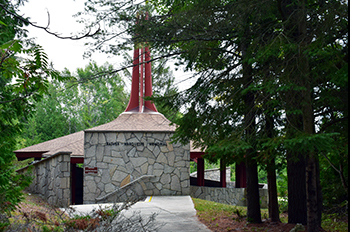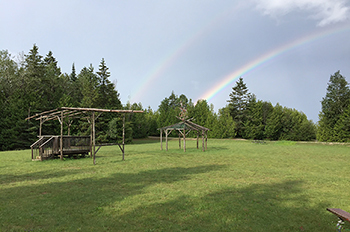|
Jan. 30, 2024
Contact: Sandra Clark, 517-243-4041 or Tobi Voigt, 517-898-6067
DNR receives $3.6 million Mellon Foundation grant to support community-driven project to share Native American history more accurately and completely at Father Marquette National Memorial

A collaborative effort to create new educational experiences and facilities at the Father Marquette National Memorial in Straits State Park, St. Ignace, has received a significant boost: a $3.6 million grant from the Mellon Foundation. The grant is part of the Mellon Foundation?s Monuments Project?? a commitment to give $500 million to transform the nation?s commemorative landscape through public ventures that more completely and accurately represent the multiplicity and complexity of American stories.
The DNR effort, which is being developed by a cooperative of local, state and tribal partners, is led by the DNR?s Michigan History Center. Called Gchi Mshiikenh Deh Minising/Heart of the Great Turtle Island, the project includes the construction of new educational structures, exhibits and art that add Native American context and perspectives to the Father Marquette National Memorial site.
The memorial, established in 1976, is one of 18 public monuments dedicated to the Jesuit missionary. With Louis Jolliet, Jacques Marquette conducted the first French exploration of the Mississippi River in 1673. The Jesuit accounts of that trip spurred the French colonization of the Mississippi Valley. Marquette?s and other Jesuit accounts from the period have long informed both historical accounts and attitudes toward the Native people of the Great Lakes.
The Gchi Mshiikenh Deh Minising/Heart of the Great Turtle Island Project recenters the narrative around the thriving Anishinaabe (Odawa, Ojibwe and Potawatomi) people and cultures whose history provides context for Father Marquette?s experiences in the region and whose impact and influence extend to the present day.
?The project has an amazing potential to tell a story of the region that has been missing, a perspective led from Native Americans with ancestral ties to the area,? said Austin Lowes, chair of the Sault Ste. Marie Tribe of Chippewa Indians. ?This investment from the Mellon Foundation will allow visitors to connect with a period of time through the lens of Native Americans that will aid in their understanding of how important the earth, the land and the waters are to everyone?s way of life. This has been a real collaborative effort with the state and tribal partners and has long had the support of our entire board of directors.?
|
Background

Moran Township provided the impetus for the project?s collaborative work, which began in 2017 and involves the Sault Ste. Marie Tribe of Chippewa Indians, the Mackinac Straits Health System, Lake Superior State University and the DNR?s Parks and Recreation Division and Michigan History Center.
The Sault Tribe named the site Gchi Mshiikenh Deh Minising, which means Heart of the Great Turtle Island. It reflects an Anishinaabe view of the Great Lakes as the heart of North America and a creation story that begins at the Straits of Mackinac.
The Bay Mills Indian Community, Little Traverse Bay Bands of Odawa Indians and Match-E-Be-Nash-She-Wish Band of Potawatomi Indians (Gun Lake Tribe) have joined the Sault Tribe and the Michigan History Center in creating the historical content plan for the site.
Grants from individuals, the National Endowment for the Humanities and the Michigan Natural Resources Trust Fund are also supporting the project.
?The Mellon Foundation gift turns the collaborative planning work of our staff and partners into reality, and for that we are both excited and grateful,? said DNR Director M. Scott Bowen. ?Known as the ?gateway to the Upper Peninsula,? Straits State Park is a popular destination year after year, welcoming visitors of all ages. Through the Great Turtle Island Project, we have the chance to reach those visitors with a more complete and accurate narrative that captures this region?s stories.?
The Mellon Foundation funding will support:
- Construction of an adaptable learning commons to house exhibitions and year-round classroom/meeting space.
- Updates of informational elements of the Father Marquette National Memorial.
- New, permanent structures at the site currently used for powwow grounds.
- A community kitchen pavilion for powwows and educational programs.
- Refreshed and new educational signage on trails.
- Public art installations commissioned by tribal partners.
- Program development.
|
Timeline

Construction on the learning commons, powwow ground structures and community kitchen pavilion is expected to begin in summer 2024 with a projected completion in 2025.
Over the next two years, the project partners will develop a permanent exhibit for the learning commons, update the exhibits in the Father Marquette National Memorial and develop new trail signage. In addition, an Anishinaabe-led committee will work on commissioning art for the site, and partners will develop specific plans for programming that serves educators, students, residents and visitors to the Straits region.
?Many Anishinaabe descendants of those who knew Marquette are Catholic and honor his facility with their languages, his faith and his courage,? said Michigan History Center Director Sandra Clark. ?It is a privilege that we can now also honor the culture that thrived before he arrived and remains an important part of Michigan.?
To learn more about the project, visit Michigan.gov/MHC/Museums/Father-Marquette-National-Memorial.
|
Note to editors: Accompanying photos are available below for download. Caption information follows. Credit Michigan Department of Natural Resources, unless otherwise noted.
-
Straits: Straits State Park, located at the north end of the Mackinac Bridge in St. Ignace, features several scenic views of the Straits of Mackinac, including this one from a trail near the Father Marquette National Memorial.
-
Memorial:?The Father Marquette National Memorial was established in 1976. The DNR manages the site. A companion museum at the site was hit by lightning and burned in 2000. It was not rebuilt.
-
Logo: The Sault Ste. Marie Tribe of Chippewa Indians developed the Heart of the Great Turtle Island logo, which depicts North America as the turtle, and the Great Lakes as its heart with the Straits of Mackinac at the heart?s center. Credit: Sault Ste. Marie Tribe of Chippewa Indians
-
Learning commons: An architectural rendering of the entrance to the learning commons.
-
Powwow grounds: For more than a decade, the clearing where the former museum stood has been used for an annual powwow. The temporary structures seen here will be replaced with permanent structures as part of this project.
-
Powwow map: The plan for the powwow grounds includes shade structures, a central drum circle, restroom facilities and a community kitchen pavilion.?
-
Site plan: The initial site plan includes the Phase 1 additions of the learning commons, powwow grounds structures, community kitchen pavilion, new interpretive trails and the existing Father Marquette National Memorial. Future phases will address a pedestrian bridge over I-75, a natural amphitheater and other grounds improvements.?
?
|